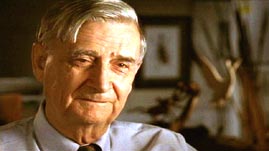Fifty million years before humankind began farming, ancient ants were already in the agriculture business.
Over time, leafcutter ants have evolved a complex system of agriculture in their nests, cultivating bumper crops of fungi that are the ants' sole food source. Foragers cut pieces of leaves from trees and drag them home to their nest, where others chew them into a paste that becomes the fungi's dinner. There are, however, at least two more participants in this relationship. Surprising the scientific community, graduate student Cameron Currie discovered a mold that threatens to kill the fungi, and the antibiotic which the ants produce in order to control it.
This alliance is an example of mutualism, a form of symbiosis, an intimate relationship between different organisms whose survival depends on one another. Other examples include bacteria that colonize human skin and digestive tracts, goby fish that live in burrows dug by marine shrimps, and aphids that feed on plant sap and excrete a sweet "honeydew" that ants find delicious.
One common instance of symbiosis teams up microbe and plant. Legume plants, such as peas and beans, have bacteria on their roots that convert nitrogen from the soil into an organic form the plants can use. The bacteria, for their part, are nourished by the plants.
Symbiotic relationships develop through co-evolution -- reciprocal adaptations between interacting species. It includes not only mutually beneficial interdependence, but also relationships in which one organism benefits and the other does not, or where neither party benefits. Often, one organism lives inside the body of the other, and sometimes it even lives within the cells of the host.
In his interview for
Evolution, E. O. Wilson asserts that, besides predation, "There's another force equally important and responsible for the buildup of a great deal of the magnificent superstructure of the earth's biodiversity. And that is cooperation, what we call symbiosis, and particularly mutualistic symbiosis, that is intimate living together of different kinds of organisms in which there's a partnership, which benefits both of the partners."


 Loading Standards
Loading Standards Teachers' Domain is proud to be a Pathways portal to the National Science Digital Library.
Teachers' Domain is proud to be a Pathways portal to the National Science Digital Library.
